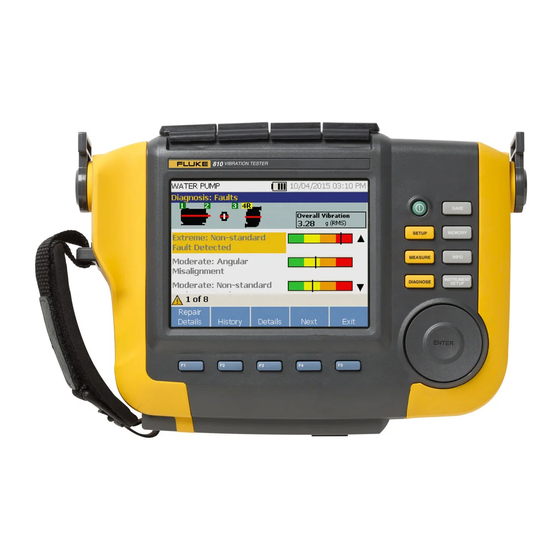
Fluke 810 Manual
Vibration tester
Hide thumbs
Also See for 810:
- User manual (156 pages) ,
- User manual (146 pages) ,
- Getting started (32 pages)
Advertisement
Quick Links
Vibration Tester
810
How to Answer the Setup Questions
for a Vibration Test with the
Fluke 810 Vibration Tester
The Fluke 810 Vibration Tester can accurately diagnose a
wide range of machine conditions, but to do so it must have
a complete and accurate description of the components being
tested and how they are configured.
To gather the required information quickly and conveniently, the
Tester asks a series of questions about the following when you
set up a new test:
• The motor that drives the system
• The couplings and transmission
• The driven component
As you answer these questions, the Fluke 810 Vibration Tester
displays an image of the system that you have described so you
.
can be sure that it has an accurate representation
Blower
Blower
Motor
Motor
Coupling
Coupling
Entering Motor Information
Entering an accurate
running speed (RPM)
is critical to receiving
a proper diagnosis.
The Fluke 810 Vibration Tester
uses the running speed that
you enter to analyze vibration
information and to give you an
accurate diagnosis. Entering
an incorrect running speed
significantly reduces the
accuracy of the tester. Use
the keypad of the Fluke 810
Vibration Tester to enter the
Figure 1
running speed. (Figure 1)
Getting the speed information for constant-speed motors
You can get the speed of a constant-speed motor from the motor nameplate or
the motor manual. You can also measure RPM with tachometer supplied with
the Fluke 810.
Getting the speed information for variable-speed motors
You can get the speed of a variable-speed motor from:
• The tachometer supplied with the Fluke 810 Vibration Tester
• A separate strobe or contact tachometer
• The information listed on the variable frequency drive
To get consistent diagnoses on motors controlled by variable speed drives
(VFDs), it may be necessary to reduce or increase the load on the motor to get
the motor speed to match the speed at which previous measurements were
made. If you can manually adjust the VFD, set the VFD to its maximum output
speed (50Hz or 60Hz).
To calculate motor speed from the VFD output setting, use the following formula:
VFD output frequency / motor nameplate frequency
×
motor nameplate speed = motor speed
For example, if the motor nameplate tells you that that motor speed at 60 Hz is
1,775 RPM and you set the VFD to 60 Hz, the motor runs at its nameplate speed:
×
60 Hz / 60 Hz
1,775 RPM = 1,775 RPM
If you reduce the VFD to half the previous output frequency, the motor runs
half as fast:
30 Hz / 60 Hz
×
1,775 RPM = 887 RPM
Using the Machine Setup Wizard
When you set up a machine for measurement and diagnosis using the
Machine Setup Wizard, answer each question carefully and correctly, based
on your knowledge of the machine to be tested. If you are unsure about
how to interpret the questions asked by the Machine Setup Wizard, refer to
the Fluke 810 Users' Manual or this guide.
• Use the Dial on the Fluke 810 to highlight your choice. (Figure 2)
• Use the softkeys to select the component, and then press Enter (Figure 3)
Figure 2
Softkeys
Figure 3
Advertisement

Subscribe to Our Youtube Channel
Summary of Contents for Fluke 810
- Page 1 Fluke 810 Users’ Manual or this guide. The Fluke 810 Vibration Tester a complete and accurate description of the components being • Use the Dial on the Fluke 810 to highlight your choice. (Figure 2) uses the running speed that tested and how they are configured.
- Page 2 Supported or Overhung Answer NO unless: component? Answer “No.” Component Use the Fluke 810 User’s Manual and this guide to help answer the setup questions • Bearings on motor and Next component: a. The driven component is physi- Next component: Belt Drive required for each test.











Need help?
Do you have a question about the 810 and is the answer not in the manual?
Questions and answers